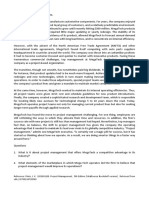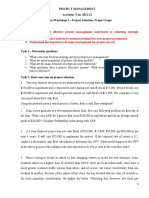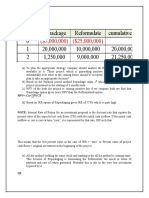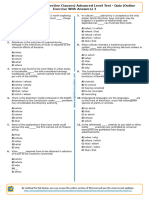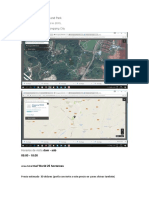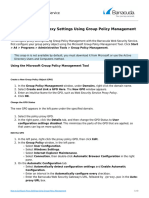Nova Western Inc Final
Nova Western Inc Final
Uploaded by
Xelina Diane LuzaranCopyright:
Available Formats
Nova Western Inc Final
Nova Western Inc Final
Uploaded by
Xelina Diane LuzaranOriginal Description:
Copyright
Available Formats
Share this document
Did you find this document useful?
Is this content inappropriate?
Copyright:
Available Formats
Nova Western Inc Final
Nova Western Inc Final
Uploaded by
Xelina Diane LuzaranCopyright:
Available Formats
Project Management (MGT 540)
Case Study #4: Project Selection at Nova Western, Inc.
Submitted to: Mr. Willy Cuason
Submitted by: Bucalbos, JC Luzaran, Xelina Mapoy, Rey Ann Mosteiro, Denise Salvador, Jocel
CASE BACKGROUND
Using different methods can yield to different things and the outcome will always be different. There are many methods on how to screen a project and the output can result in distinctive ways. The checklist method can have a conclusion different from other methods because how a project is evaluated is not similar to others. The case has two projects proposal but only one can be done because of budget constraints. Project Janus supported by the Software Development Group of the company and Project Gemini by Business Applications Organizations. The company used a weighted scoring model and the output was that Project Gemini is better of the two with the criteria given. Another approach was used, the Discounted Cash Flow, which the results were in favor of Project Janus because of the greater returns on initial investment. Phyllis Henry, the vice president of new product development, will present to the top management his recommendations and he is not yet confident on what to give as an answer.
STATEMENT OF THE PROBLEM In dilemmas where a decision has to be made in choosing one of the two options is not an easy task to do especially in cases that involves big money. Projects in organizations involve the use of money and often times it requires a lot. Management has to pick the best option because it will use time and resources but in some cases if all projects can be funded then it can be executed but involves of more risk. The case is in a dilemma of choosing between the two proposed projects and only one can be funded. The scoring model suggests that Project Gemini is the choice for the next new project. On the other hand, NPV analysis suggests the other project, which is Project Janus. It is clear that the results of the two methods that have been mentioned in the case are conflicting. Given this predicament, what are other possible project selection methods, which will support the claim of either the scoring model or the NPV analysis, that can aid Nova in choosing the right project?
ALTERNATIVE SOLUTIONS The group considers two alternatives to help the company determine which project should be carried out. One must keep in mind that the alternative to be chosen here is to be used considering that previous methods - weighted scoring and NPV - have already been done. These are different from those examples present in the case but are to be added to them to help the firm.
1) Analytical Hierarchy Process (AHP)
a. In this process, there are three criteria for evaluating project alternatives: (1) Financial benefits, (2) Contribution to strategy, and (3) Contribution to IT
infrastructure. The Financial benefits criterion, which focuses on the tangible benefits of the project, is further subdivided into long-term and short-term benefits. Contribution to strategy, an intangible factor, is subdivided into three sub criteria: (a) Increasing market share for product X; (b) Retaining existing customers for product Y; and (c) Improving cost management. Because the hierarchy can reflect the structure of organizational strategy and critical success factors, it also provides a way to select and justify projects according to their consistency with business objectives.
b. AHP requires that all criteria be fully exposed and accounted for at the beginning of the selection process. c. Application: In the case, there are strategic categories. The group would divide these according to the three criteria for evaluating project alternatives as seen in the table below. Three Main AHP Criteria 1. Contribution to Financial Benefits Key Categories of Nova (as divided by the group) - NPV computed - Potential profit - Strategic fit - Strategic leverage - Probability of technical success
Subcategories 1a) Long-term benefits 1b)Short-term benefits 2a) increasing market share for the products 2b) retaining existing customers for existing product lines 2c) Improving Cost Management
3. Contribution to Strategy
6. Contribution to IT infrastructure
The AHP Process is advisable because this is a more intensive view of the different aspects of the projects. Aside from that, there is the division, organization, and prioritizing of categories. If one has got all the necessary information from top-to-bottom, the AHP process is advisable. A software, called Expert Choice is also used by Experts to apply AHP.
2) Payback Period
The Payback Period is another alternative because the rates of return for each project are given already. Using Excel application on this, Project Geminis and Project Januss Payback Period is determined.
Using the simple Payback Period WITHOUT incorporating the discount rate,
Project Janus
Years 0 1 2 3 4 5 Cash Flow (250,000) 50,000 100,000 100,000 200,000 75,000 50,000 150,000 250,000 450,000 525,000 recovered the capital in 3 years Cum. Cash Flow
Project Gemini
Years 0 1 2 3 Cash Flow (400,000) 75,000 250,000 300,000 75,000 325,000 625,000 Recovered between 1st and 2nd year. Cum. Cash Flow
With the use of Rates of Returns for 15% for the Discounted Payback Period, the years slightly go higher but STILL, Project Gemini has the earlier recovery period than Project Janus.
Project Janus
Year 0 1 2 3
Cash Flow (250,000) 50,000 100,000 100,000
0.869565217391304 0.756143667296787 0.657516232431988
43,478.26 75,614.37 65,751.62
43,478.26 119,092.63 184,844.25 Between years 3 and 4. According to Excel, specifically 3 years and 7 months.
200,000
0.571753245593033
114,350.65
299,194.90
75,000
0.497176735298290
37,288.26
336,483.16
Project Gemini
Year 0 1 2 3 Cash Flow (400,000) 75,000 250,000 300,000 0.869565217391304 0.756143667296787 0.657516232431988 65,217.39 189,035.92 197,254.87 65,217.39 254,253.31 451,508.18 Between years 2 and 3. According to Excel, specifically 2 years and 9 months.
Using the Payback Period Method, the group realizes that even if Project Janus has a higher NPV than Project Gemini as recognized in the book, in terms of Payback Period, the company will gain back its investment faster with Project Gemini.
RECOMMENDATION Considering the project selection methods that the company has tested, the Weighted Scoring Model and NPV Analysis, the group recommends the Payback Period Financial Model Analysis, which supplements the claim of the Weighted Scoring Model, as another project selection method that Nova Western Inc. can consider. In choosing project to be executed, it is necessary to always take into consideration its relative importance, as well as the money it will generate in the future upon execution. Thus, it is a bad idea to consider only one aspect of the project, such as the financial capability of the project only.
Although AHP is an effective project selection method, considering that it exemplifies a very detailed list of possible outcomes of the project, this is more advisable in the future. This is more applicable and effective to use if there are more than enough given data from the company to make an extensive rating for each criterion. In this case, the data given is very limited. Hence, the group chooses the Payback Period Model over AHP. One major reason as to why the group recommends the Payback Period Model as an Alternative Project Selection Method is that it supports the results of one of the methods that Nova Western has tested, that is, the Weighted Scoring Model.
ANSWER TO CASE QUESTIONS 1. Phyllis has called you into her office to help her make sense of the contradictions in project evaluation. How would you explain the reasons for this divergence of opinion from one technique to the next? What are the strengths and weaknesses of each screening method? The results of the two selection methods performed by the company, specifically the scoring model and the NPV analysis, have clearly yielded opposite outcomes. The scoring model, a non-financial screening method, suggests that Project Gemini is the right choice for the next new project. On the other hand, the NPV Analysis, a financial screening method, suggests the opposite. It is not uncommon for financial and non-financial screening methods to yield competing information; thus an argument can be made that using only these two methods is insufficient. Another screening model/s should be developed, which will give assurance that Nova will be able to select the next best project. Below is a table that lists the strengths and weaknesses of the screening methods that have been mentioned in the case as well as the other alternative methods that have been suggested by the group. This table will help the company to know which method/s is/are appropriate to use to make the wisest decision. SCREENING METHODS Scoring Model STRENGTHS Appropriate to use in terms of knowing whether a project is aligned with the companys strategic goals or not Easy to use and to comprehend as well WEAKNESSES The rating scale (1 3 or above) that is used is not very accurate There is no certainty whether the link between the selected/chosen criteria and the companys strategic goals are 100% aligned or not Ignores probabilities and risk Assumes that financial projections are accurate
NPV Analysis
Easy method to execute Ensures that the company will invest in a project that will
definitely generate profit
AHP
Ability to rank choices relative to their effectiveness in meeting conflicting objectives Ability to detect inconsistent judgments
Payback Period
Allows the company to make a more intelligent determination of the length of time needed to satisfy the initial project investment (Pinto, 2010) Easy to compute
Assumes that strategic considerations are irrelevant Fails to deal with constrained resources Difficulty in making accurate long-term predictions It only works because the matrices are all of the same mathematical form known as a positive reciprocal matrix. (Coyle, 2004) The rating scale that is used is not very accurate and is not standardized Leaves out information regarding profitability during project payback periods as well as any profits made after payback periods end
2. Choose the project that you feel, based on the above analysis, Nova Western should select. Defend your choice. Considering all project selection methods both the methods stated in the case and the methods suggested by the group that apply to the case of Nova Western, the group decided to choose Project Gemini as the best project to be executed. Both projects are profitable. Both have relative importance to the market and to the company. However, they differ on the level or height of profitability and importance. So, the best way to look which project is better to select is to know how long it will take for the project to pay back its initial budget and begin to generate positive cash flow for the company. Taking into account the rationale behind the NPV Analysis that it recognizes the time value of a money (a $ received today is worth more than a $ received tomorrow), it measures the projects true profitability, and it has a value additively, Project Janus is the best project since it offers a higher net present value for the initial investment. However, when it comes to its relative importance as tested by the Weighted Scoring Method, Gemini is the choice. Hence, the results are contradicting. Therefore, the only solution to know which of the two projects is to be chosen is to conduct the payback period analysis. Based on the computations and analysis above, although Project Janus has higher NPV, its payback period is two years longer than Project Gemini. So, if
the firm does not wish to tie its money up too long, Gemini might be a reasonable alternative. Likewise, the weighted criteria model also favors Project Gemini. Hence, among the four project selection methods, two of them support Project Gemini as the best project to choose.
3. What does the above case suggest to you about the use of project selection methods in organizations? How would you resolve the contradictions found in this example? A lot of opportunities are coming in many firms. However, the top managers have to make a good decision in order to succeed. That is why using projection selection method is very important for many organizations since it will help them in choosing the best choice among the options within the usual constraints of time and money. Based on the case, Phyllis staff constructed two projection selection methods in order to determine which project they have to support: scoring model or NPV analysis. However, there were problems in the results because it yielded different findings. Project Gemini was the best alternative in the scoring model while Project Janus has the higher NPV. From this conflict, the group suggested that it would be better to use another selection criterion so that to avoid biases and it would be easier for the top management to decide the best project that would give positive impacts in the company.
LEARNINGS Project Selection is one of the tough decisions that an organization has to deal with since many resources are at stake, especially money. In choosing the right project to execute, it is best to always consider not only the possible revenue that it will generate in the future but also its relative importance to the market and to the company itself. A projects profitability mainly depends in its importance in the market. In choosing the best project, there will be at least three evaluations to conduct by the top management in order to avoid biases in the organization. Moreover, the decision will be more precise since the project that will be supported has good evaluations. In choosing projects for organizations, choose the projects that will have long-term benefits. In addition, it is better to have more evaluations for each project to determine the best option. Project Selection is not a fast process - especially if it involves a huge amount of money (as most cases do in project management). It lies on the hands of the managers - not the top ones but those who will actually overlook the project - to maintain good judgment on choosing the right one. Most of the time, this will involve going through more than one method. Even in the end, there is no assurance that the predictions would happen. After all, it was a prediction. It could also be a tedious process especially because results may vary, but with the right head and good timing, choosing can be easier and helpful.
SOURCES Cooper, R. (2010-2012). Portfolio Management: Fundamental for New Product Success. StageGate International and Product Development Institute Inc. Coyle, G. (2004). The Analytical Hierarchy Process. In Practical Strategy: Structured tools and techniques. Pearson Education Limited 2004. Open Access Material Pinto, J. (2010). Project Management: Achieving Competitive Advantage, Second Edition. New Jersey: Prentice Hall
You might also like
- AFC Coaches Log BookDocument10 pagesAFC Coaches Log BookRais Fakhri Bin Azha100% (3)
- PM Assignment 2Document4 pagesPM Assignment 2Juan Quiroz67% (3)
- Nova WesternDocument19 pagesNova Westernadel22100% (1)
- Manual OltDocument136 pagesManual Oltcarlos juniorNo ratings yet
- MGT 403 Core Syllabus 2017-1Document7 pagesMGT 403 Core Syllabus 2017-1manoseth0% (1)
- 3Document3 pages3omNo ratings yet
- Heublein Project Management and Control SystemDocument4 pagesHeublein Project Management and Control SystemGuilherme Da Silva Costa100% (4)
- MS Excel Word Powerpoint MCQsDocument64 pagesMS Excel Word Powerpoint MCQsNASAR IQBAL50% (2)
- Fodor - Reply To Steven PinkerDocument8 pagesFodor - Reply To Steven PinkerflipindoreNo ratings yet
- Non Circular Air Cooler Design CalculationsDocument50 pagesNon Circular Air Cooler Design CalculationsSyedZainAliNo ratings yet
- WEEK 2-The Organization Context Strategy, Structure and CultureDocument38 pagesWEEK 2-The Organization Context Strategy, Structure and CultureSabri JamilNo ratings yet
- Pay Back PeriodDocument4 pagesPay Back PeriodVarun AiyengarNo ratings yet
- Case Study 1.1 - MegaTech Incorporation PDFDocument1 pageCase Study 1.1 - MegaTech Incorporation PDFShiv NeelNo ratings yet
- Revised AA1 - Exercises - All ChaptersDocument14 pagesRevised AA1 - Exercises - All ChaptersLinh Khanh TranNo ratings yet
- 601 1,2,7 SolutionsDocument30 pages601 1,2,7 Solutionscoolankit10No ratings yet
- Kelly Consulting CaseDocument18 pagesKelly Consulting CaseJavid BalakishiyevNo ratings yet
- Question Bank (CHE-S508) PDFDocument5 pagesQuestion Bank (CHE-S508) PDFDHEERESH KUMARNo ratings yet
- Đ Bích Trâm 1632300129 HW Week 4Document8 pagesĐ Bích Trâm 1632300129 HW Week 4GuruBaluLeoKingNo ratings yet
- Operman ReportDocument52 pagesOperman Reportyuki yuki0% (1)
- Explain How You Would Conduct A Job Analysis in A Company That Has Never Had Job DescriptionsDocument3 pagesExplain How You Would Conduct A Job Analysis in A Company That Has Never Had Job DescriptionsN. Azad100% (1)
- International Business MGMTDocument4 pagesInternational Business MGMTdevi ghimireNo ratings yet
- UWS Project Overview of Sydney Opera House - EditedDocument11 pagesUWS Project Overview of Sydney Opera House - EditedZoya zafar100% (1)
- Layout Design AssignmentDocument2 pagesLayout Design Assignmentesatuse2022No ratings yet
- ACTG 243 Decision Making With Accounting Information Final Exam 01Document3 pagesACTG 243 Decision Making With Accounting Information Final Exam 01Đinh Ngọc Minh ChâuNo ratings yet
- Chapter 4 Types of Strategy XGimbert ENGLISHDocument20 pagesChapter 4 Types of Strategy XGimbert ENGLISHjoanNo ratings yet
- Assignment Semester 4 BduDocument4 pagesAssignment Semester 4 Bdusagar0290% (1)
- Exam Project Development Midterm Exam Ay 21-22Document3 pagesExam Project Development Midterm Exam Ay 21-22Unknwn UknwonNo ratings yet
- Function and Role of Financial SystemsDocument33 pagesFunction and Role of Financial Systemsaamirjewani100% (1)
- Non-Discounting Criteria Discounting CriteriaDocument89 pagesNon-Discounting Criteria Discounting CriteriaAytenew AbebeNo ratings yet
- Project Management Academic Year 2021-22 Seminar/Workshop 3 - Project Selection. Project ScopeDocument5 pagesProject Management Academic Year 2021-22 Seminar/Workshop 3 - Project Selection. Project ScopebonuNo ratings yet
- Proj Chap 2Document10 pagesProj Chap 2mohdarifshaikh100% (2)
- Environmental Cost Management: Kelompok 1: Hilmy Fauzan Novia Kumala Sari Try SusantiDocument34 pagesEnvironmental Cost Management: Kelompok 1: Hilmy Fauzan Novia Kumala Sari Try SusantiSeptian RizkyNo ratings yet
- Capital Budgeting Decision Is An Important, Crucial and Critical Business Decision Due ToDocument7 pagesCapital Budgeting Decision Is An Important, Crucial and Critical Business Decision Due ToGaganNo ratings yet
- 1632 490 Chapter1.DiscussionDocument4 pages1632 490 Chapter1.DiscussionShiva Subramanya100% (2)
- Creativity and InnovationDocument4 pagesCreativity and InnovationAlexNo ratings yet
- Operationsmanagement - IntroductionDocument19 pagesOperationsmanagement - IntroductionGunjan BangaNo ratings yet
- Adaptive Vs Extreme PMLCDocument5 pagesAdaptive Vs Extreme PMLCMuslim KarimjeeNo ratings yet
- Management Control SYSTEM Attempt All QuestionsDocument19 pagesManagement Control SYSTEM Attempt All QuestionsSailpoint CourseNo ratings yet
- Session 5Document25 pagesSession 5Vaishnavi SomaniNo ratings yet
- PM0008Document5 pagesPM0008souvik_dazNo ratings yet
- Case Study3.2Document2 pagesCase Study3.2ramaalsousNo ratings yet
- Fopm Assignment 2Document6 pagesFopm Assignment 2Muiz SaddozaiNo ratings yet
- Project ManagementDocument11 pagesProject Managementfozi12345No ratings yet
- 1 Part III Speeding Up Deployment ReturnsDocument7 pages1 Part III Speeding Up Deployment ReturnsPatrick ZamoraNo ratings yet
- Sotero 05SeatWork1 ProjDocument3 pagesSotero 05SeatWork1 Projbernadette soteroNo ratings yet
- Readings - Capital Budgeting - 2Document12 pagesReadings - Capital Budgeting - 2Anish AdhikariNo ratings yet
- Assignment 2Document8 pagesAssignment 2ouma alphonceNo ratings yet
- BABOKDocument333 pagesBABOKanshul2503No ratings yet
- Master of Business Administration-MBA Semester 2 MB0049 - PROJECT MANAGEMENT - 4 Credits (Book ID: B1632) Assignment Set - 1Document11 pagesMaster of Business Administration-MBA Semester 2 MB0049 - PROJECT MANAGEMENT - 4 Credits (Book ID: B1632) Assignment Set - 1Aman GuptaNo ratings yet
- PD Unit Final TopicDocument21 pagesPD Unit Final TopicAna Melisa G. MuegaNo ratings yet
- Multiple Project Selection Methods For Project ManagersDocument4 pagesMultiple Project Selection Methods For Project ManagersMuhammad FaizanNo ratings yet
- Project InitiationDocument8 pagesProject Initiationbhatara hulubalangNo ratings yet
- Unit-2 Cost Benfit AnalysisDocument15 pagesUnit-2 Cost Benfit AnalysisrajniNo ratings yet
- Chapter2 AligningSelectionProjectsDocument36 pagesChapter2 AligningSelectionProjectsZeynep SenerNo ratings yet
- SPMDocument8 pagesSPMchitranshhNo ratings yet
- Apply Project Cost Management Techniques - TASK 1Document4 pagesApply Project Cost Management Techniques - TASK 1Raí SilveiraNo ratings yet
- Balance Sheet. This Asset, Except in The of A Non-Depreciable Asset Like Land, IsDocument10 pagesBalance Sheet. This Asset, Except in The of A Non-Depreciable Asset Like Land, IsCharu ModiNo ratings yet
- BSBPMG533 Task 1Document5 pagesBSBPMG533 Task 1ryanmai2804No ratings yet
- cost benefit analysis 2Document3 pagescost benefit analysis 2mainavitalis254No ratings yet
- Forecasting&PlanningDocument30 pagesForecasting&PlanningkristinaNo ratings yet
- For New Products. Once The Management Team Defines Projects, EachDocument2 pagesFor New Products. Once The Management Team Defines Projects, Eachcevsa distribucionesNo ratings yet
- Year Repackage Reformulate Cumulative Cf. 0 1 20,000,000 10,000,000 20,000,000 2 1,250,000 9,000,000 21,250,000Document9 pagesYear Repackage Reformulate Cumulative Cf. 0 1 20,000,000 10,000,000 20,000,000 2 1,250,000 9,000,000 21,250,000Manish BansalNo ratings yet
- Wa0071.Document12 pagesWa0071.eliza ChaleNo ratings yet
- Project Managem-WPS OfficeDocument10 pagesProject Managem-WPS OfficeKirosTeklehaimanotNo ratings yet
- Punjab Agricultural UniversityDocument6 pagesPunjab Agricultural UniversitySheetal NagpalNo ratings yet
- Error SpottingDocument3 pagesError SpottingselvambhrNo ratings yet
- MaanthiDocument5 pagesMaanthia1n2u3s4h5a6100% (1)
- Malik Melli 20175377 Research Paper Kengo Kuma PDFDocument22 pagesMalik Melli 20175377 Research Paper Kengo Kuma PDFMalik MillyNo ratings yet
- Product Manual BT700D: Bloomfoss Pte LTDDocument5 pagesProduct Manual BT700D: Bloomfoss Pte LTDStathis MoumousisNo ratings yet
- 4th Sunday of AdventDocument4 pages4th Sunday of AdventAjay SimonNo ratings yet
- 345 - Relative Clauses Adjective Clauses Advanced Level Test Quiz Online Exercise With Answers 3Document4 pages345 - Relative Clauses Adjective Clauses Advanced Level Test Quiz Online Exercise With Answers 3uyenha.ulisNo ratings yet
- Salkowski Test & ConclusionDocument3 pagesSalkowski Test & ConclusionJezKagandahan40% (5)
- Lehe Ledu Wildlife Zoo and ParkDocument13 pagesLehe Ledu Wildlife Zoo and ParkMaría MoncayoNo ratings yet
- Reference Letter Graduate AdmissionDocument4 pagesReference Letter Graduate Admissionfrebulnfg100% (2)
- Condition MonitoringDocument8 pagesCondition MonitoringStephanie FlemingNo ratings yet
- How To Clean Effectively: A Cleaning Guide For Food Business Operators, Owners and Managers of Food BusinessesDocument24 pagesHow To Clean Effectively: A Cleaning Guide For Food Business Operators, Owners and Managers of Food Businesseshiba JamalNo ratings yet
- Nokia X3 RM-540 DisassyInstructionV1 PDFDocument7 pagesNokia X3 RM-540 DisassyInstructionV1 PDFingwilson75No ratings yet
- Quiz QuestionsDocument5 pagesQuiz QuestionsShreeshNo ratings yet
- Reported By: Sr. Jinggle U. Emata John Erick S Enero Calamba Doctors' CollegeDocument35 pagesReported By: Sr. Jinggle U. Emata John Erick S Enero Calamba Doctors' CollegeMarivic DianoNo ratings yet
- Intelligent Quality Optimiser: (IQ-501) SeriesDocument8 pagesIntelligent Quality Optimiser: (IQ-501) SeriesAbhijeet SrivastavaNo ratings yet
- How To Configure Proxy Settings Using Group Policy ManagementDocument3 pagesHow To Configure Proxy Settings Using Group Policy ManagementYohanna Monsalvez RojasNo ratings yet
- Notification in FlutterDocument5 pagesNotification in Fluttersmama hsnNo ratings yet
- Makalah Neni Andiny-1Document15 pagesMakalah Neni Andiny-1다딘No ratings yet
- F1-C1 Intro To ScienceDocument190 pagesF1-C1 Intro To SciencejayaletchumiNo ratings yet
- WFH Internships JDDocument7 pagesWFH Internships JDAsia NehaNo ratings yet
- Sat Sleeve Hotspot User ManualDocument115 pagesSat Sleeve Hotspot User Manualkapiw45478No ratings yet
- Practitioner S Guide To Audit of Small Entities Revised 2020Document224 pagesPractitioner S Guide To Audit of Small Entities Revised 2020vijayNo ratings yet
- !!! E-Portfolio Assessment RubricDocument2 pages!!! E-Portfolio Assessment RubrickamaNo ratings yet
- ICAIDocument4 pagesICAImilinthakkar7629No ratings yet
- Api 570 310-10Document3 pagesApi 570 310-10NIMANo ratings yet












